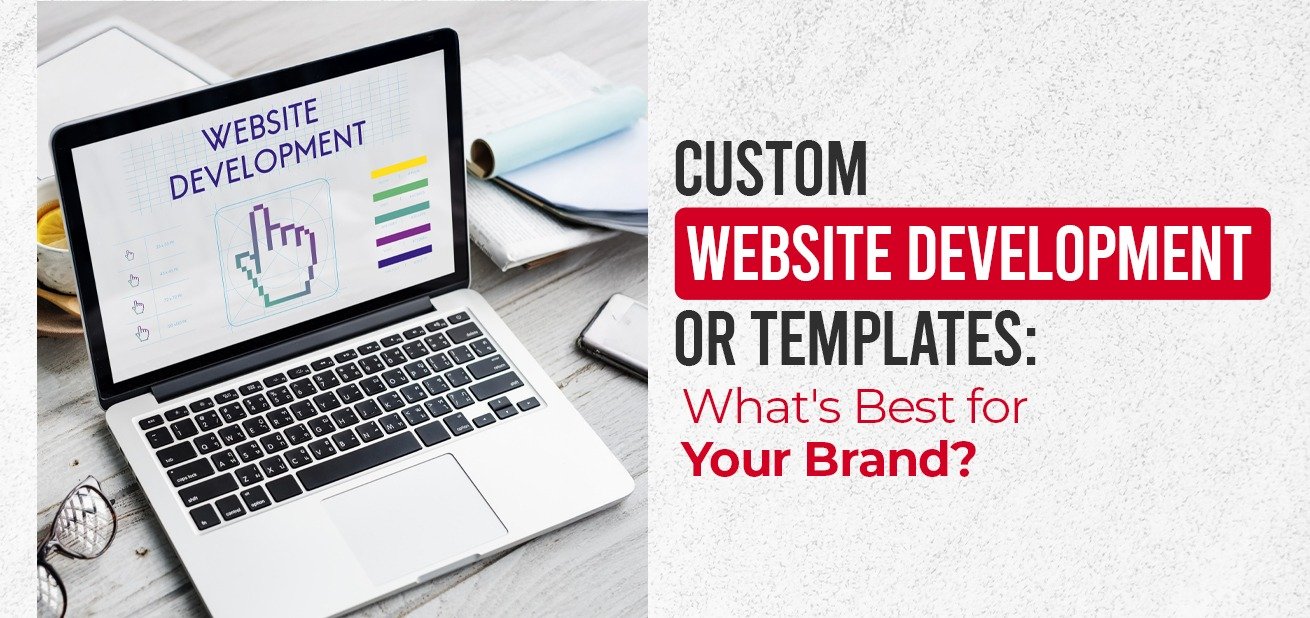
Custom Website Development or Templates: What's Best for Your Brand?
Whenever you come across any brand, what do you do?
Search Google to see if they have a website.
A website is a brand’s digital touchpoint. A well-built website is crucial for a brand to tell its story and make users stay and take action on the website. It defines a brand’s success online. Having a website is non-negotiable for any brand, but how to make a website is the question now. There are two ways: making a custom website from scratch or using a pre-designed template.
In this article, we’ll discuss the pros and cons of both ways of website development and how to choose which way to go.
Did you know?
It takes only 0.05 seconds to form an opinion about a website, according to SEMRush.
Custom Website Development: What it is and its pros and cons
Custom website development involves creating a website from scratch by developing custom code, functionality, layout, font, colour and design. Everything is customised according to the brand. One can decide what to include and what not to include in a custom website, unlike templates.
Creating a custom website is a time-consuming process and needs more financial resources as well. It involves a team of web developers, UI/UX designers, QA testers, content writers and many more.
Pros of Custom Website Development
- Full control: With a custom website, one can tailor every element according to the brand’s personality – fonts, colours, images, videos, layout, etc. There’s no limitation on creativity.
- Tailored user experience (UX): UX design can be customised from home page to checkout to make the user experience seamless and unique. Fun quizzes, interactive pages, custom forms, chatbots and so many more things can be added.
- Flexible functionality: There’s no need to spend extra on functionalities a website doesn’t need, as it is custom and can be tailored according to the brand’s requirements. Even if a brand needs to have any additional features, it is easy to add.
- Easy to scale: It is easy to scale and add on more functionalities and features to a custom website, as they are designed and structured for the long term. Apart from the ease to scale, custom websites perform well in terms of speed and SEO even after scaling. Performance is not an issue with custom websites.
- More secure: There are no limitations on custom websites in terms of adding additional security features, unlike template-based websites.
Cons of Custom Website Development
ime-consuming: A custom website takes time to get ready and launch, as it needs to be made from scratch. From layout and design to coding and functionality, everything needs to be made.
Expensive: Making a custom website involves a team of specialists, which increases the cost of human resources. Additionally, the cost increases further with customisations. The initial costs are higher in comparison to template-based websites.
Who should go for Custom Website Development?
- Brands which are in a niche business
- Brands which need a tailored user experience
- Big brands with an in-house team of website developers and designers.
Template-based Websites: What it is and its pros and cons
Template-based websites are made using pre-designed templates available online on website builders. They come with pre-designed website layouts and functionalities, which can be quickly customised to a brand’s requirements.
Templates are quicker and easier to make than custom websites. They don’t require a professional developer to build a website. A person with a basic understanding can also create a website. There are a lot of website builders on which a brand can make their website. They are: Shopify, WordPress, Wix, WooCommerce, etc.
Pros of Template-based Websites
- Speed of Execution: A template is quick and easy to execute as the design and layout are already ready. The functionality and third-party apps and integrations need to be customised, and the brand’s data needs to be replaced. It is ready to go live in a short period.
- Lower cost: The templates available online are either free or paid. Even the paid ones are more affordable than custom website development costs.
- Built & tested by experts: The templates are built by experts who deploy the best practices. They are responsive and have a user-friendly design.
- Variety of options available: There are a lot of website templates available online. One can choose depending on the industry and business they are in.
Cons of Template-based Websites
- Limited customisation options: While website templates can be customised, it is limited. Adding unique features and making a custom code for any feature is not possible.
- Performance issues: Adding a lot of plugins and features can sometimes slow down the website’s speed and affect its performance.
Who should go for Template-based Websites
- Brands which are tight on budget
- Professionals requiring a website for online presence
- Brands which are short on time
Making the choice: Custom Website Development vs Templates
Choosing the right way to go for a brand’s website depends on a brand’s requirements and factors such as time, budget, maintenance, etc. Consider the following factors before choosing:
- Stage of business and budget
- Timeline for the launch of the website
- Need for customisation
- Functionalities required
- Resources you have
Creating Shopify Websites with The Pencil Advertising
If you choose to go with a template-based website, The Pencil Advertising will help you create a seamless website for your e-commerce business. We specialise in creating e-commerce website development services. We have officially partnered with Shopify for website development services.
Connect with us on Instagram or reach out to us here, and our team will reach out to you.
Let’s grow your business together!

Crafting eCommerce Success Stories
- A-303, Mondeal Height,Ramdevnagar
- S.G Highway, Ahmedabad - 380015
- +91-8141090685